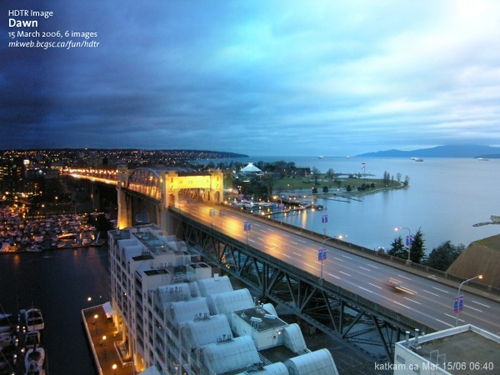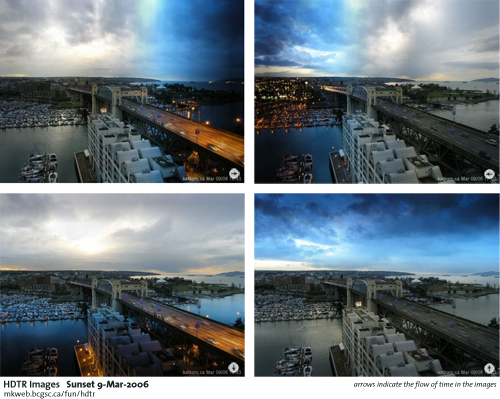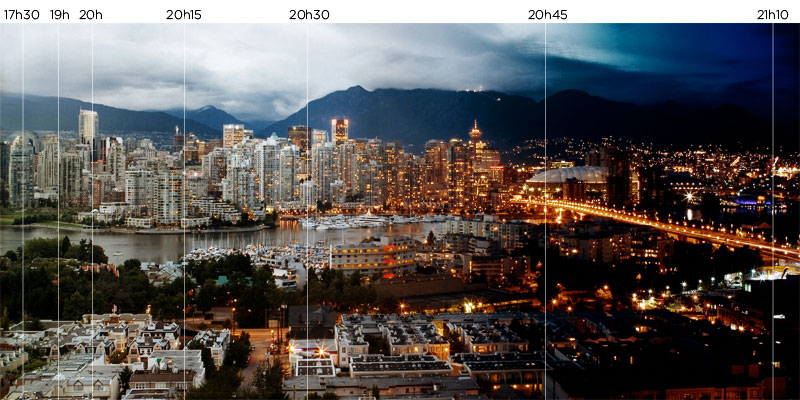featured images


Nearly all the HDTR images I have made so far are of the same subject - the Burrard Street Bridge in Vancouver, Canada. The images are served by katkam.ca, a local web cam broadcasting images of the Burrard Bridge, every 5 minutes.
If you have time-lapse images that you'd like me to try processing, let me know.
high-resolution HDTR
Using a 20D and the TC-80N3 remote, I captured the Vancouver skyline from about 6pm to 10pm. The camera was on a tripod. The images were shot in RAW format and subsequently processed with Adobe Lightroom.
Minor white balance and exposure adjustments were made across the series to limit banding during the stitching process. Original exposure was determined using a Sekonic L-608 incident meter, though once the sun had set, the meter ceased to be useful and exposure was adjusted based on the shape of the brightness histogram.
I took images every 5 minutes to start, and increased the frequency when the light was rapidly changing during sunset. From the entire stack of images, I selected 60 across the time range for stitching.

The final stitched image is shown below, representing time flow from 6pm (left) to 10pm (right).

full day
Snapshots of a full day worth of images.

Very challenging light conditions near sunset caused many adjacent images to be very different in brightness. The web cam's exposure was constantly fluctuating - at one point changing from 1/100s f/3.2 -1/3EV compensation to 1/160s f/4 -2/3EV compensation from one frame to the next. Such a drastic change of about 1 1/3 f-stops should be avoided when making HDTR images. I admit fiddling with the final output in Photoshop.

Images from 13:30 - 16:40 were removed from input due to extreme lightness in the frames. The remaining frames were temporally blended (weights = 1,2,2,4,4,4,6,4,4,4,2,2,1) and spatial blending was also applied. This high level of temporal blending was possible because the capture interval was decreased for the last 30 minutes, thus providing more samples for the interesting dusk.

The same day and blending as for the image above, but this time frames from 13:30 - 14:00 were added to the HDTR image. The effect is to add brightness to the transition from the blue sky of the midday to the darker sky of the sunset.

dawn to dusk
In the dawn to dusk series, only images from dawn or dusk were used. Images from daytime were not included in making the HDTR frames.

It rained all day giving Burrard Street a slick, mirror finish

A couple of street lamps near the right edge of the frame are off. Is it burned out bulbs or HDTR?

A blue color cast dominates all the dawn to dusk images. The web cam is performing auto white balancing, I suspect, but is not capable of correctly determining the colour temperature for these frames. I removed some blue in post-processing, but decided to leave the tint in to avoid losing saturation.

Another transition from morning to night.
parts of a day


An HDTR created with only 6 input images shows dawn. Time flow is left to right in the first image, and reversed in the second.

It rains a lot in Vancouver. January 06 was particularly wet, setting a variety of unpleasant records. Here's one such rainy dusk.
flow of time

Altering the direction of time flow in the HDTR image yields interesting effects. Here, I composited 2 hours worth of images at sunset, stacking the images in different "directions".

Another time-flow experiment. It is critical to maintain the same white balance across the set of images. In the input stack of images for these HDTRs, the web cam drastically adjusted white balance requiring significant post-processing to avoid a sharp tint boundary.

Four time flows at dawn. Luckily the white balance for the input image set was well behaved. No post-procesing was necessary. These HDTRs include both spatial and temporal blending - that's what makes them so creamy.
time flow composites
Using the stack of images shown below,

I generated four blends in which the arrow of time is indicated on the image.

Interesting parts of each image were blended together to form the composite below. The time flow in this final image is a complicated vector field.

weather patterns

It's one thing when time flows across an image, and another when the weather is radically changing. This image portrays one hour on 10 March 2006, starting at about 6am. Vancouver saw a very heavy (relative for Vancouver) snow storm the previous night and it began to snow again in the morning. You can see that it is snowing in the right half of the image.
























